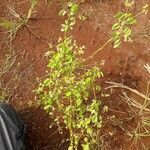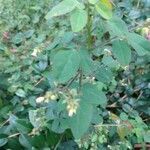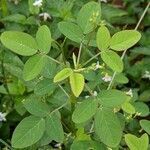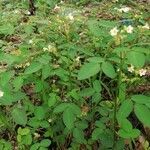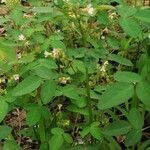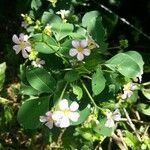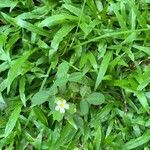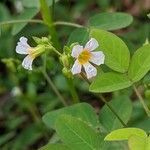Perennial herb to subshrub with stems up to 1.5 m high, stolons and rhizomes absent, bulbs and bulbils absent. Stem branched, sparsely patent to appressed-reflexed pubescent. Indumentum of simple hairs, the hairs straight or bent below the middle, eglandular. Stipules absent. Leaves subopposite, pinnately trifoliolate; petiole 1.5–9 cm long, continued into a rachis 5–15 mm long below terminal leaflet, appressed-puberulous; leaflets: lateral leaflets subsessile, terminal leaflet largest and on a rachis, elliptic to oblong, 10–55 mm long, 8–25 mm wide, cuneate to emarginate at base, entire, rounded to obtuse at apex, not emarginate, glabrous above, strigose margin, glaucous and sparsely to moderately appressed-pubescent below; calli absent. Inflorescence cymose, 2-or 4-branched, each branch monochasially several-flowered, but sometimes contracted and umbelliform; peduncle usually 2.5–5.5 cm long, pubescent; pedicels 1–3 mm long. Bracts situated at base of pedicels, linear, 1–2 mm long, pubescent, calli absent. Sepals narrowly ovate, acute, 2–4 mm long, glabrous or with a few hairs, calli absent. Petals narrowly obovate, rounded, 6–9 mm long, pale lilac or pinkish white with yellowish or white base, glabrous. Stamens at 2 levels, the shorter set glabrous, those of the longer set with a dorsal tooth. Ovary glabrous. Styles with ascending strigose hairs. Capsules ovoid, 5–10 mm long, c. 4.5 mm wide, 5-lobed, 5-angled, glabrous. Seeds ± flattened-ovoid, transversally ridged.
Erect herb, stem up to 1.5 m, without bulbs or stolons. Stem branched, sparsely patent to ap-pressed-reflexed pubescent, glabrescent; hairs simple, straight or bent below the middle, eglandular. Leaves usually more or less opposite, pinnately 3-foliolate, exstipulate; petiole 2-9 cm, appressed-puberulous; leaflets elliptic to oblong, base cuneate to emarginate, apex obtuse to rounded, not notched, ecallose, glabrous above, margins strigose, especially at base, beneath pale and glaucous, sparsely to moderately appressed pubescent, terminal leaflets largest, 1-3.5 by ½-2½ cm. Peduncles 3-5.5 cm, pubescent, once or twice dichasially forked; branches up to 4.5 cm, 4-16-flowered, the bracts opposite the flowers. Bracteoles minute, ciliate, ecallose. Pedicels 1½-3 mm, glabrous. Sepals 2-4 by ½-1¼ mm, ovate-lanceolate, acute, glabrous or with a few hairs, ecallose, 3-nerved. Petals 6-9 by 2-2½ mm, obovate-lanceolate, apex rounded, after anthesis rolling inwards, pink, lower half greenish with yellow spots, glabrous. Filaments (MF) ¾-1 and 1¾-2¼ mm, the shorter glabrous, the longer with a dorsal tooth, patent-hairy. Ovary 1 by 0.5 mm, glabrous; styles (MF) 1-1½ mm, ascendingly stri-gose; stigmas small, capitate; ovules 4 per cell, in 1 row. Fruit 5-10 by 3-5 mm, slightly ovoid, 5-angular, apex and base 5-lobed, glabrous; episeptal rimae present. Seeds 3-4 per cell, 10.5 by 1 mm, ± flattened-ovoid; testa transversally ridged.
Erect branched herb, often woody at the base, 15–60 cm. high, densely leafy from the base.. Leaves alternate or fasciculate, pinnately 3-foliolate; leaflets lanceolate to ovate-lanceolate, narrowed at both ends, glabrous above and hairy beneath; terminal leaflet the largest, 13–55 mm. long and 9–31 mm. wide, with a stalk up to 10 mm. long, the lateral ones 12–35 mm. long and 5–24 mm. wide, subsessile; petiole about as long as the terminal leaflet, tomentose and not widening into a stipule at the base.. Inflorescence cymose, determinate at first, becoming bifid and indeterminate with branches up to20 mm. long, but sometimes contracted and umbelliform; peduncles axillary near ends of stem and branches, 4–7 cm. long; bracts linear, 1–1.5 mm. long, acute, pubescent; pedicels 2–5 mm. long, jointed at 1 mm. from the base.. Sepals linear-lanceolate, 3.5–5 mm. long, acute, membranous, puberulous.. Petals white, pink or purplish, with 2 yellow spots at the base, spathulate, cuneate, 7–8 mm. long.. Stamen-tube 1.5 mm. long; long filaments dentate in the middle, puberulous; short filaments not dentate, glabrous.. Ovary oblong, glabrous; styles longer than both stamen whorls, or intermediate between them in length and hirsute, or shorter and glabrous.. Capsule ovoid to oblong, ending bluntly at each end, up to 11 mm. long and 4.5 mm. in diameter.. Seeds 3 per locule, 2.5 mm. long, flattened, ± 4-angled, acuminate, rugose.
A herb. It can grow 1.5 m high. It does not have runners or bulbs,
